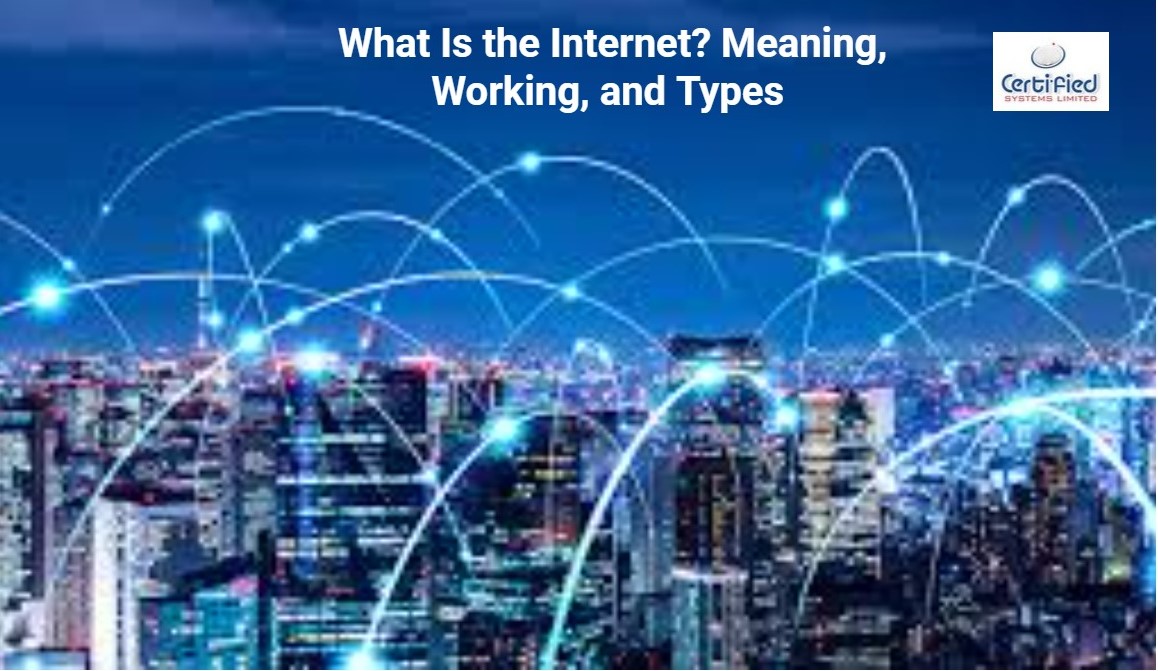The internet is a global network of devices that communicate using the TCP protocol.
- The internet is defined as a global network of linked computers, servers, phones, and smart appliances that communicate with each other using the transmission control protocol (TCP) standard to enable the fast exchange of information and files, along with other types of services.
- This article explains the meaning, inner workings, and the most popular types of internet.
Table of Contents
- What is the internet?
- How Does the Internet Work?
- Types Of Internet Services?
What Is the Internet?
The internet is a global network of interconnected computers, servers, phones, and smart appliances that communicate with each other using the transmission control protocol (TCP) standard to enable a fast exchange of information and files, along with other types of services.
he internet is a global hub of computer networks — a network of connections wherein users at any workstation may, with authorization, receive data from every other system (and often interact with users working on other computers).
Internet infrastructure comprises optical fiber data transmission cables or copper wires, as well as numerous additional networking infrastructures, such as local area networks(LAN), wide area networks (WAN), metropolitan area networks (MAN), etc. Sometimes wireless services such as 4G and 5G or WiFi necessitate similar physical cable installations for internet access.
Internet Corporation for Assigned Names and Numbers (ICANN) in the United States controls the internet and its associated technologies, such as IP addresses.
How was the internet developed?
The internet was first envisioned in the form of ARPANET by the Advanced Research Projects Agency (ARPA) of the U.S. government in 1969. The initial goal was to create a network that would enable users of a research computer at one institution to “communicate” with research computers at another institution. Since communications can be sent or diverted across several directions, ARPANet could continue to operate even if a military strike or any other calamity damages portions of the network.
ARPANET used the new packet switching technology to create low-cost, interactive interactions between computers, which generally communicate in short data bursts. Packet switching broke down large transmissions (or portions of computer data) into smaller, more manageable parts (called packets) that could travel independently across any accessible circuit to the destination where they were reassembled. Consequently, unlike conventional voice services, packet switching doesn’t require a separate dedicated connection between a pair of users.
In the 1970s, corporate packet networks were launched, although their primary purpose was to enable efficient access to distant computers through specialized terminals. They replaced expensive long-distance modem connections with “virtual” lines via packet networks.
Today, the internet is a globally accessible, collaborative, and self-sustaining public resource available to tens of millions of individuals. Countless people utilize it as their primary source of data consumption, spurring the development and expansion of their own community through social networking and content exchange. However, private versions of the internet do exist, which are primarily used by large organizations for secure and regulated information exchange.
Key features of the internet
The internet is a vast, interconnected network of computers and other network-enabled devices, which is:
- Globally available: The internet is an international service with universal access. People living in isolated areas of an archipelago or even in the depths of Africa can now access the internet.
- Easy to use: The software used to connect to the internet (web browser) is user-friendly and easy to understand. It’s also relatively easy to create.
- Compatible with other types of media: The internet provides a high level of engagement with photos and videos, among other media.
- Affordable: Internet service development, as well as maintenance costs, are modest.
- Flexible: Internet-based communication is highly adaptable. It supports text, audio, and video communication. These services are available at both individual and organizational levels.
How Does the Internet Work?
The internet delivers different types of information and media across networked devices. It operates using an internet protocol (IP) and a transport control protocol(TCP) packet routing network. Whenever you visit a website, your computer or mobile device requests the server using such protocols.
A server is where web pages are stored, and it functions similarly to the hard drive of a computer, except with far greater processing power. The server accesses the web page and delivers the right information to your computer whenever the request arrives. This is broadly the end-to-end user experience. Let us now look at the more technical details of how the internet works.
1. Connecting computers
The basic foundation of the internet is an interconnected network of computers. When two computers interact, they must be physically (often via an Ethernet connection) or wirelessly connected (via Wi-Fi or Bluetooth). All modern systems can support any of these connections to establish a core network.
2. Scaling computer networks
The computer network, as described above, is not restricted to two PCs. One can link several computers. However, as you expand, it may get more complex. Every machine on a network is connected to a tiny computing device known as a router to address this problem. This router’s only function is to operate as a signaler. It ensures that a message transmitted from a particular computer reaches its intended recipient. With the addition of a router, a system of 10 computers needs merely ten wires instead of 10 × 10 = 100 connections.
3. Enabling infinite scaling
Let us now discuss interconnecting hundreds of thousands to billions of machines. A single router cannot scale to that extent; nonetheless, a router is an independently programmable computer unit. This implies that two or more routers may be connected, enabling infinite scaling.
4. Utilizing ubiquitous public infrastructure via a modem
By now, we have constructed a network identical to the internet, although it is only intended for individual use and cannot connect with the outside world. This is where public infrastructure comes in. The telephone system links an office to everyone worldwide, making it the ideal wiring configuration for the internet. A modem is necessary for connecting networks to the telephone system. This modem converts data from a network into data that can be managed by the telephony architecture and vice versa.
5. Sending messages from one network to another
The following step is to transmit the information from your network to the target network. To accomplish this, the network must establish a connection with an internet service provider (ISP). An ISP is a service that administers specified routers that are interconnected and also have access to the routers of other ISPs. Therefore, the data from the host network is delivered to the target network via the web of ISP networks.
To deliver a message to a system, it is important to identify which computer it should be sent to. Therefore, every machine connected to a network has a unique identifying address known as an “IP address” (here, IP refers to internet protocol). It is an address consisting of four integers separated by periods, such as 192.168.2.10. There are several versions of IP; currently, we are in IPv4 and IPv6 iterations, depending on the region.
6. Assigning domain name to IP addresses
IP addresses are intended for computers, but in an infinitely extensible internet, it would be difficult for people to keep count of an ever-growing number of addresses. To simplify matters, one may designate an IP address with a domain name, a human-readable name. Google.com is an excellent example of this — the domain name is used in conjunction with the IP address 142.250.190.78. Therefore, typing the domain name is the simplest way to access a computer online.
7. Connected the internet to the web
The internet is a network architecture that enables millions of machines to communicate with one another. Several of these machines (web servers) can feed web browsers intelligible messages. The web is an application constructed on top of the internet’s infrastructure. It is important to note that additional services, like email, have been developed on top of the internet.
8. Connecting the internet to a private intranet or extranet
Intranets are personal and bespoke network confined to an organization’s members. They offer participants a secure gateway to access shared information, collaborate, and communicate.
Extranets are quite similar to intranets, except that they enable collaboration and sharing with other businesses. Typically, they are employed to safely and confidentially transmit information to customers and other enterprise stakeholders. Frequently, their functions resemble those of an intranet: file and information sharing, collaboration tools, message boards, etc.
Intranets and extranets operate on the same infrastructure and adhere to the same protocols as the internet.

